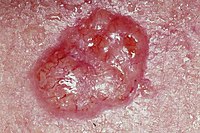
Photo from wikipedia
Importance Ultraviolet radiation exposure is an important modifiable risk factor for keratinocyte carcinoma (KC) in fair-skinned non-Hispanic White populations; however, the evidence for this relationship in darker-skinned populations is less… Click to show full abstract
Importance Ultraviolet radiation exposure is an important modifiable risk factor for keratinocyte carcinoma (KC) in fair-skinned non-Hispanic White populations; however, the evidence for this relationship in darker-skinned populations is less certain. Objective To assess and synthesize the published data concerning the association between UV exposure and the risk of KC in individuals with skin of color. Evidence Review PubMed, Cochrane, and Web of Science databases were searched from database origin through January 2022. Studies deemed eligible included UV exposure as a risk factor for KC in individuals with skin of color, defined as any race other than non-Hispanic White, Fitzpatrick skin types IV to VI, or tanning ability of rarely or never burns. The UV index, irradiance, latitude, history of phototherapy, history of sunburn, or occupational exposure were used as measures of exposure. The Oxford Centre for Evidence-Based Medicine guidelines were used to assess evidence quality. Findings A total of 72 716 articles appeared in the search. After duplicate removal, 29 393 database records were screened, 454 full-text articles were assessed, a forward and reverse citation search was performed, and 12 articles, with clinical data spanning the years 1990 to 2019, met inclusion criteria. More than 32 970 KCs in individuals with skin of color were included. Eight studies found no association between UV exposure and KC, while 4 studies showed a positive association. Study types included 1 ecological study, 9 cohort studies, and 2 case-control studies. The quality of the studies was rated from moderate to low (2b to 4). Conclusions and Relevance Results of this systematic review show that the evidence assessing the association of UV exposure with KC is of moderate to low quality. The studies that found no association were among patients receiving phototherapy. Studies assessing nonphototherapy-related UV exposure, such as geographic location or occupation, found small positive associations in primarily East Asian individuals. There were no studies performed in the US, no studies among Black individuals, and only 1 study among a Hispanic population. Further research is required to better assess whether these associations exist across populations of patients with darker skin types.
Journal Title: JAMA dermatology
Year Published: 2022
Link to full text (if available)
Share on Social Media: Sign Up to like & get
recommendations!